Hobby Boss 1/48 F4F-3S "Wildcatfish"
Before the war, the Imperial Japanese Navy wasn't the only one concerned about the provision of air power in an island campaign across the Pacific. The U.S. Navy was also well aware that between the time the troops stormed ashore and the time an airfield could be constructed, the limited number of aircraft carriers could not remain in the vicinity of the invasion as targets for enemy ships, aircraft and submarines. Fortunately for the American Navy, the solution to this problem would come by the militarization of American industrial construction methods, which led the world for ability to handle large projects at a high rate of construction. Japanese military officers after the war would state that the American ability to quickly construct airfields and port facilities was the major reason why they lost the Solomons, where they were not able to complete one new airfield in total during the entire campaign up to the capture of Bougainville in October 1943.
In late 1941, however, this was all in the future, and the Navy was gravely concerned with the problem of air cover following invasion. Like the Japanese naval air force, the Bureau of Aeronautics decided that a floatplane fighter would be the solution. While the Japanese at first commissioned a designed‑for‑the‑purpose fighter ‑ the N1K1 Kyofu (Rex) ‑ and then later adapted the Zero as the A6M2‑N when the development of the N1K1 slowed, the U.S. Navy decided to adapt an existing fighter from the outset.
In early 1942, the Edo Corporation was contracted to convert one F4F‑3 to a floatplane configuration as the F4F‑3S. Unlike most Navy floatplanes, this did not have a centerline float and two wingtip floats ‑ as did the A6M2‑N ‑ but was equipped with twin main floats. Faced with a need for such an airplane, the Navy proceeded to change a contract for 100 F4F‑7 long‑range recon Wildcats with Grumman to an additional 100 F4F‑3s.
By the time the F4F‑3S flew on February 28, 1943, the Navy's SeaBee construction battalions had proved their worth, and the program was canceled. The conversion took three months to complete. Initial flight tests revealed directional instability that resulted in the addition of a substantial ventral fin in addition to the smaller fins on the horizontal stabilizers. Top speed was reduced to 254 m.p.h., which was considered barely acceptable. The 100 F4F‑3s on the production line were finished as land planes during early 1943 ‑ the last Wildcats built by Grumman ‑ and assigned to Training Command. This would prove fortunate for history, as the three F4F‑3s ditched in Lake Michigan during the war and later recovered in the 1980s were from this batch, and now constitute the only three early Wildcats still in existence.
Over the years, modelers have been intrigued by the Wildcatfish. During the 1970s at least two adventurous souls I knew took the Monogram Wildcat, a pair of Monogram Kingfishers, added quite a bit of scratchbuilding ability, and kitbashed Wildcatfish models.
Back in 2001, Cutting Edge released a pricy conversion set to be used with the Tamiya F4F‑4, with two large resin floats and resin fins and rudders, and white metal struts and beaching gear. This still required the modeler to convert the folding‑wing F4F‑4 to a stiff‑wing F4F‑3, which involved filling in the fold line and the outer gun bay in each wing, sanding those areas smooth and then rescribing all the engraved detail. Outside of one guy I know here in Southern California, wildcat‑loving modelers took a pass on the project at t hat point.
In 2002, Dave Schemel created an F4F‑3 conversion set for the Tamiya Wildcat, that completely replaced the wing sub‑assembly of the kit with a one‑piece resin wing. This made a Wildcatfish project much easier.
Needless to say, at a cost of $26.00 for the Tamiya Kit, $50.00 for the Cutting Edge conversion and $40.00 for the Just Plane Stuff wing conversion, a modeler has to be extremely interested in the F4F‑3S to step up to this project. Now that both The Cutting Edge conversion and the wing conversion sets are long out of production, with collector's prices approaching a few hundred dollars in total, such a project is impossible for all but the most committed modelers.
Fortunately, Hobby Boss has come to the rescue. I for one never thought I would see the F4F-3S done as a kit from a major mainstream manufacturer, but as the list of aircraft already out as models has increased, a company like Hobby Boss needs to look further and further afield for new products. This has resulted in good kits of the Focke-Wulf Ta-152C, of which perhaps five ever flew, and the BV-141B, of which even fewer ever flew. Thus, it's not so surprising that the company would turn to a one-off prototype, particularly when they have already done a normal F4F-3, which cuts a considerable bit off of design costs for such a product. At a price of around $45, which is what I saw two going for at the LHS recently, this is a very reasonably-priced project.
The kit provides an F4F-3 kit, with a fuselage sprue that has the wheel wells filled in, and a set of floats and struts on another sprue. Decals are provided to do the one and only F4F-3S.
Anyone who has built a Hobby Boss 1/48 Wildcat knows that the kit is essentially a scaled-down version of the 1/32 Trumpeter kit. Where the Tamiya F4F-4 provides highly accurate surface detail with raised rivets where appropriate and lapped panels on the fuselage, this kit provides all that in engraved detail. This is really not a problem once the model is painted.
The cockpit is simple, with sufficient detail to look good if one provides a set of seatbelts. Unlike the Tamiya kit, which has a cockpit floor appropriate for an FM-2 Wildcat, this kit provides the narrow “bridge” floor of the earlier versions.
Without an open wheel well, it isn't necessary to use the detail parts for the rear of the engine, since that won't be seen. Assembly of the airframe is simple, and took only a few hours to complete.
Unlike the Cutting Edge conversion, which has parts that don't really fit together, the floats and struts provided here fit the way they should, and once each float and its associated struts is assembled, they attach to the wings and fuselage without problem.
As with most Wildcat kits, the sliding canopy provided really won't sit right in the open position. Those modelers who want to open up the cockpit should get hold of the Squadron/Falcon vacuformed canopy, which works perfectly.
Since I was doing the one-and-only prototype, which was very clean from the few photos available, I did not pre-shade the model, but instead did some post-shading so that the bluegrey/light grey camouflage is not completely monotone. I used Xtracrylix Blue-Grey and Light Gull Grey for this.
I didn't like the decals that came with the kit, so I used a set of Wildcat national insignia from Yellow Wings Decals. These were the only markings.
I painted the beaching gear Interior Green, attached the wheels and then attached the beaching gear to the floats. I then gave the model an overall coat of Micro-Scale “Flat.” I did not weather the model further.
Like I said, I never expected to see this Wildcat sub-type appear as a mainstream injection-molded kit. Hobby Boss has done a good job here in presenting this rare and highly-interesting subject, which presents absolutely no problems in assembly. Any modeler with a few kits completed should have no difficulty at all with this kit. A modeler interested in “what if” models could have a lot of fun making the floatplane fighter that never went to war with this kit. Highly recommended.
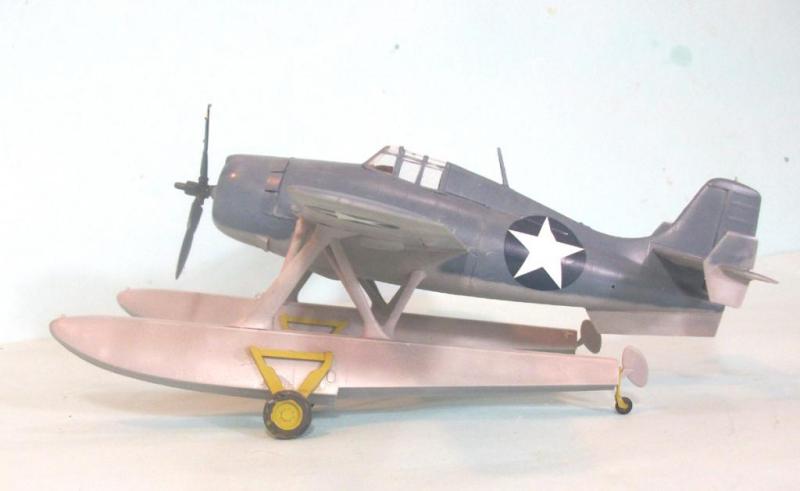
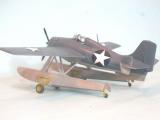
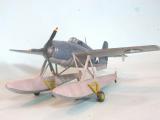
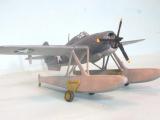
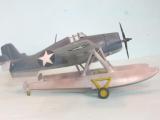

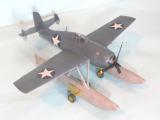
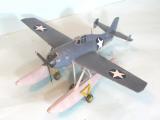
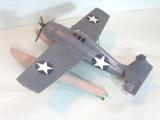
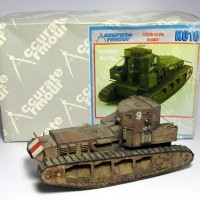

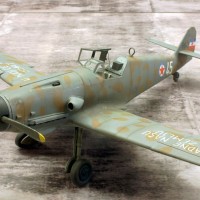
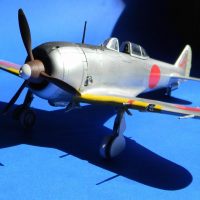
I have this kit, and now I have some inspiration to build it!
Cute lil' Wildcat Tom! Again, another unusual, seldom-seen subject from you, thanks for keeping it interesting brother!
Gary
Well, well, Mr Cleaver is back in the saddle...
Despite the disclaimer that it's not too difficult a kit etc, I can tell you're pleased with it, as I think it may be the first photo essay I've seen of yours with anything other than a three-quarter front viewing reference.
Nice one.
very cool subject and model...i think it would have sold better 20 years ago but it's neat to see something wild and crazy...great job...now if i could just hear the wail of the banshee it would make my day
The only reason the Banshee is going to wail is because it will arrive over-engineered by the same genius who brought us the F-101A/C.
The only reason the Banshee is going to wail is because it will arrive over-engineered by the same genius who brought us the F-101A/C.
My impression of the F-101 engineering had more to do with the liberal use of Guinness more than Genius.
Too true!
Faith and begorrah! And sure it won't be the Banshee that's wailing! It'll be us, her victims turning the air over the ol' workbench blue, at the interesting way the parts go together. God bless the work!
Lots of folks are commenting some good things about these Hobby Boss kits that are coming to market as of late. The Wildcat with the edo's looks to be a competent kit and to be a conversation piece for folks who are into collecting Grumman's first Monoplane Naval fighter.
Two thumbs up on the article and build. Good to see your back into building the plastic TC.
Nice job Tom, from your photo work, it appears your eye surgury was successful. Looks like the boys from the "Iron Works" thought they were building a warren truss pontoon bridge. Not the kind of thing you'd expect out of Grumman.
Actually, the whole pontoons thing is an Edo design project. It's actually pretty clean, two sets of N struts and the inner brace - like what Edo did for the TBD and the SB2U on floats.